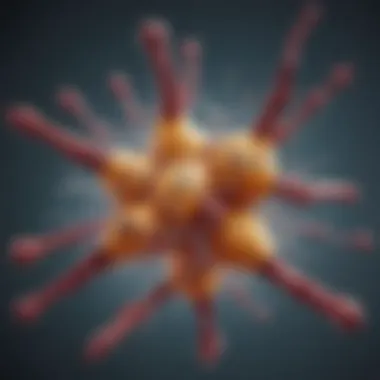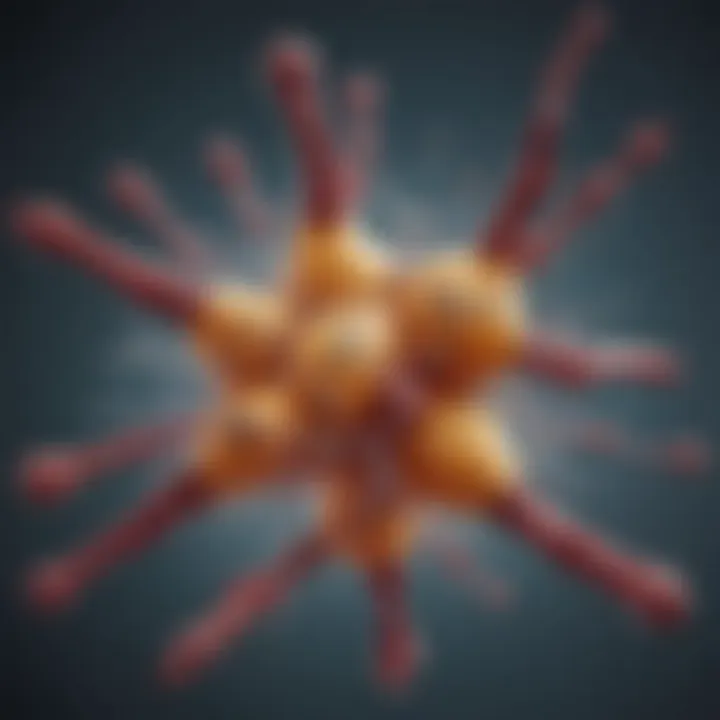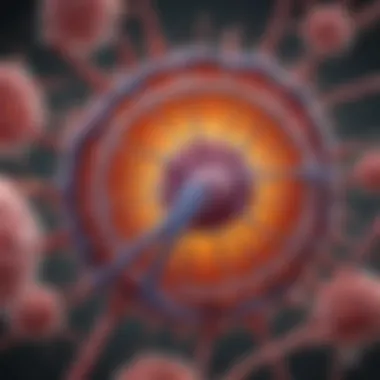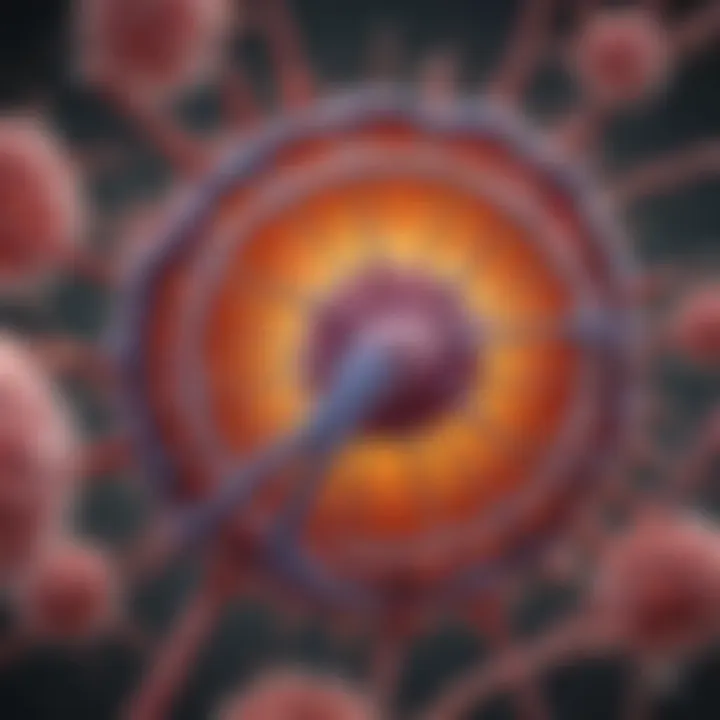Exploring Lipofectamine RNAiMAX in Gene Delivery


Intro
Lipofectamine RNAiMAX serves as a key reagent in the field of molecular biology, particularly for the transfection of RNA. This methodology has emerged as crucial for various applications, including gene silencing and therapeutic advancements. Understanding its mechanisms, formulations, and applications allows researchers to harness its potential effectively. By analyzing its benefits and challenges in RNA delivery, we aim to provide a comprehensive overview of this valuable tool and its implications in both research and clinical settings.
Research Overview
Summary of Key Findings
Lipofectamine RNAiMAX is known for its efficiency and versatility in transfecting RNA into diverse cell types. Key findings include:
- High transfection efficiency: RNAiMAX shows superior ability for effective transfection compared to multiple other reagents.
- Broad applicability: This reagent can work with various cell lines, including difficult-to-transfect cells, enhancing research versatility.
- Optimized formulation: Understanding the components and their roles is essential for maximizing its efficacy.
Background and Context
The demand for effective gene delivery methods has increased significantly with advancements in gene therapy and research. Lipofectamine RNAiMAX has positioned itself as an essential tool by addressing the limitations of earlier techniques. Increased understanding of RNA biology and the need for precise gene modulation in various applications has driven its development and optimization. The transition from conventional transfection methods to more modern approaches highlights the relevance of Lipofectamine RNAiMAX in current research agendas.
Methodology
Experimental Design
In exploring Lipofectamine RNAiMAX, it is important to consider its experimental underpinnings. Researchers typically assess various parameters, including:
- RNA concentration: Optimal concentrations can significantly enhance transfection outcomes.
- Cell density: The density of the host cells varies based on the specific experiment and can influence transfection efficiency.
- Incubation time: Variations in incubation time post-transfection allow for optimized expression of the RNA target.
Data Collection Techniques
Evaluation of Lipofectamine RNAiMAX typically involves several data collection techniques, such as:
- Flow cytometry: Used to analyze transfection efficiency quantitatively.
- Quantitative PCR: Helps in assessing the expression levels of target genes following transfection.
- Western blot analysis: Provides insights into protein expression, confirming the functional impact of RNA transfection.
"Lipofectamine RNAiMAX enables researchers to achieve targeted gene modulation with a high degree of reliability and precision."
Prelude to Lipofectamine RNAiMAX
Lipofectamine RNAiMAX has emerged as a crucial tool in molecular biology, providing researchers with an efficient method for delivering RNA-based therapeutics into various cell types. This section serves to provide an overview of this reagent, detailing its significance, function, and the context within the evolving landscape of gene delivery technologies. Understanding Lipofectamine RNAiMAX is not merely academic; it has tangible implications for advancements in gene therapy, functional genomics, and precision medicine.
Definition and Purpose
Lipofectamine RNAiMAX is a lipid-based transfection reagent designed specifically for RNA delivery into cells. Its primary purpose is to facilitate the uptake of small interfering RNA (siRNA) and messenger RNA (mRNA) into target cells. This is particularly valuable when aiming to silence genes or express new proteins through RNA interference mechanisms.
The formulation of Lipofectamine RNAiMAX optimizes the transfection efficiency while minimizing potential cytotoxic effects. This balance makes it a preferred choice among researchers for various experimental protocols involving RNA manipulation. By employing Lipofectamine RNAiMAX, scientists can enhance the introduction of nucleic acids into cells, which allows for deeper exploration into gene functions and regulatory pathways.
Historical Context
The technology underlying Lipofectamine RNAiMAX can be traced back to advancements in the field of gene delivery in the late 20th century. Lipid-based transfection strategies were developed as alternatives to traditional viral vectors notorious for their complexity and potential safety concerns. As the efficacy of these lipid formulations improved, they gained traction in laboratories worldwide.
Initially, the use of lipids for gene delivery faced several challenges, such as low transfection efficiency and high toxicity. However, with continuous research and innovation in formulation, Lipofectamine RNAiMAX was introduced, significantly improving upon earlier versions of lipid-based reagents. This evolution has enabled researchers to conduct gene silencing studies and therapeutic applications with greater success and reliability.
In summary, the introduction of Lipofectamine RNAiMAX marks a pivotal moment in the domain of RNA transfection, bridging gaps between scientific inquiry and practical application. Understanding its definition and historical background establishes a foundation for exploring its mechanisms, optimization strategies, and broader applications in subsequent sections.
Chemical Composition of Lipofectamine RNAiMAX
The chemical composition of Lipofectamine RNAiMAX plays a critical role in its functionality as an RNA delivery agent. Understanding the various components is essential for researchers aiming to optimize its use in transfection protocols. The distinctive formulation of Lipofectamine RNAiMAX not only enables efficient encapsulation of nucleic acids but also enhances cellular uptake, thereby influencing overall delivery efficiency.
Lipid Composition
At the core of Lipofectamine RNAiMAX is its lipid-based structure, which is fundamental to its mechanism of action. The formulation typically includes a mix of cationic and neutral lipids. Cationic lipids are positively charged and interact favorably with negatively charged RNA molecules. This interaction facilitates the formation of lipid-RNA complexes, which are crucial for transfection.


Typically, the cationic lipids used can enhance cellular uptake through endocytosis, a process where cells engulf external materials. Some of the commonly used lipids in Lipofectamine RNAiMAX include DOPE (1,2-dioleoyl-sn-glycero-3-phosphoethanolamine) and DOTAP (1,2-Dioleoyl-3-trimethylammonium-propane). This lipid composition is optimized to create stable liposomes that protect RNA and promote its delivery to target cells.
Additives and Enhancers
The formulation of Lipofectamine RNAiMAX also includes various additives and enhancers which improve its overall efficacy. These components work synergistically to aid in the transfection process. Some of the most notable additives are:
- Buffering Agents: These ensure that the pH levels remain optimal during the transfection process.
- Stabilizing Agents: They provide physical stability to the liposomes, preventing premature degradation of the RNA.
- Transfection Enhancers: Such as the proprietary agents in Lipofectamine RNAiMAX, which facilitate enhanced efficiency through improved cellular interactions.
These additives serve not just to enhance delivery but also to mitigate potential toxicities that can arise from the primary lipids. The careful balance in the formulation makes Lipofectamine RNAiMAX suitable for various cell types, which can differ in their sensitivity to transfection reagents.
Mechanism of Action
Understanding the mechanism of action for Lipofectamine RNAiMAX is crucial for maximizing its potential in gene delivery. This section explores the specific interactions at the cellular level, focusing on how Lipofectamine facilitates the introduction of RNA into target cells. These mechanisms highlight the benefits and considerations that researchers must be aware of when employing this reagent in their experiments.
Cell Membrane Interactions
The first step in gene delivery via Lipofectamine RNAiMAX involves interactions with the cell membrane. The lipid components of Lipofectamine are formulated to assist with membrane fusion, allowing the RNA complex entry into the cell.
- Lipid-Protein Interactions: The positive charge of Lipofectamine RNAiMAX associates with the negatively charged phospholipid bilayer of the cell membrane. This interaction is key for the initial binding.
- Endocytosis: Once bound, cells typically internalize the Lipofectamine-RNA complex through a process called endocytosis. This involves the cell membrane wrapping around the complex, creating a vesicle that brings the material into the cell.
- Factors Influencing Efficiency: Factors such as membrane fluidity and cholesterol content can affect how efficiently Lipofectamine interacts with the cell surface. Understanding these parameters can help in optimizing transfection protocols.
Endosomal Escape Mechanisms
Once inside the cell, Lipofectamine RNAiMAX must escape the endosomal vesicles to release RNA into the cytoplasm. This step is essential for successful gene silencing.
- pH-Dependent Mechanisms: As endosomes mature, they become more acidic. Lipofectamine has been shown to destabilize endosomal membranes in low pH environments, facilitating the release of RNA into the cytosolic space.
- Membrane Fusion: The lipids in Lipofectamine can integrate with endosomal membranes, creating pores that allow the RNA to flow out. The capability of Lipofectamine to induce membrane fusion is critical for ensuring that the RNA reaches its intended site of action.
- Optimization Considerations: Transfection conditions such as incubation time and temperature can influence the extent of endosomal escape. Adjusting these factors can enhance the overall efficiency of Lipofectamine RNAiMAX in delivering RNA payloads.
Dynamic endosomal escape is vital to ensure that the therapeutic RNA reaches the cytoplasm where it can exert its gene-silencing effects.
The mechanisms of action underlying Lipofectamine RNAiMAX’s functionality reveal the sophisticated biochemical processes that enhance gene delivery. This insight helps researchers refine their protocols and achieve more reliable outcomes.
Optimal Use of Lipofectamine RNAiMAX
Understanding the optimal use of Lipofectamine RNAiMAX is crucial for maximizing its effectiveness in gene delivery. Proper application can significantly affect transfection efficiency and overall experimental outcomes. Factors such as cell type, RNA concentration, and the timing of transfection are critical elements that can lead to successful results. In this section, we will explore these factors in detail to provide a roadmap for best practices.
Cell Type Considerations
Different cell types exhibit unique features that influence their susceptibility to transfection. For instance, adherent cell types such as HEK293 and HeLa cells respond more favorably to Lipofectamine RNAiMAX than suspension cells, like lymphocytes. This is due to variations in cellular membrane characteristics and endocytic pathways.
Key points include:
- Adherence: Adherent cells allow for longer contact with the transfection reagent, enhancing uptake.
- Growth Phase: Transfection is often more effective when cells are in the log phase of growth, as they are more metabolically active.
- Cell Density: Fixing optimal cell density before transfection increases the likelihood of successful RNA uptake, preventing overcrowding or insufficient contact with reagent.
Optimizing RNA Concentration
The concentration of RNA used in transfections directly impacts the efficiency of Lipofectamine RNAiMAX. If the concentration is too low, the quantity of delivered RNA may not be sufficient to elicit a response. Conversely, an excessively high concentration can introduce toxicity, leading to cell death.
Recommendations for optimal concentration:
- Consult Datasheets: Initial experiments should start with recommended RNA concentrations found in product datasheets.
- Titration Experiments: Perform titration studies by testing a range of concentrations to identify the most effective dose for a specific cell type.
- Quality of RNA: Use high-quality RNA to ensure maximum efficiency in transfection. Degraded RNA may hinder successful delivery.
Transfection Timing and Conditions
The timing and conditions under which transfection occurs can considerably influence outcomes. Factors such as incubation time, temperature, and environmental conditions play a vital role in optimizing transfection.
Considerations include:
- Incubation Period: The ideal incubation time with Lipofectamine RNAiMAX should align with the protocol recommendations, often ranging from a few hours to overnight, depending on the cell type.
- Environmental Settings: Maintaining physiological conditions, such as temperature and humidity, is essential for cell viability and transfection efficacy.
- Post-Transfection Recovery: Once transfection is completed, cells should be allowed to recover. Providing a recovery period before any subsequent analysis ensures that cells can express the delivered RNA effectively.


"Optimizing conditions during transfection can dramatically affect the results, ultimately influencing research outcomes."
Applications in Research
The applications of Lipofectamine RNAiMAX in research are significant. This reagent has transformed how scientists study gene function and regulation. Its ability to deliver RNA molecules effectively into various cell types enables precise manipulation of gene expression. This has profound implications for understanding biological pathways and disease mechanisms.
Gene Silencing Studies
Gene silencing studies represent a vital aspect of research that benefits from the use of Lipofectamine RNAiMAX. This methodology allows researchers to inhibit specific genes, thereby evaluating their roles in cellular processes. By employing small interfering RNAs (siRNAs), scientists can silence target genes with high specificity and efficiency. The use of Lipofectamine RNAiMAX helps to enhance the delivery of these siRNAs, optimizing transfection rates across different cell lines.
Benefits of using Lipofectamine RNAiMAX for gene silencing include:
- High Efficiency: It ensures a significant reduction in target gene expression. This is crucial for validating gene function.
- Versatility: It works effectively with various cell types, making it a popular choice in laboratories.
- Rapid Results: Researchers can observe phenotypic changes within a short time after gene silencing.
Moreover, these studies facilitate the understanding of genetic pathways related to diseases. For example, by silencing genes implicated in cancer, researchers can elucidate how these genes contribute to tumor growth and proliferation. This knowledge could guide the development of targeted therapies in the future.
Functional Genomics
Functional genomics is another key application of Lipofectamine RNAiMAX. This field focuses on understanding the functions of genes and their products. It employs high-throughput techniques to investigate how genes interact within biological systems. Utilizing Lipofectamine RNAiMAX enables researchers to perform RNA interference in a systematic manner. This leads to a detailed analysis of gene functions and their involvement in complex pathways.
In functional genomics, the following factors are critical:
- Gene Interaction Mapping: Researchers can assess how silencing certain genes affects others. This mapping provides insights into regulatory networks and molecular interactions.
- Phenotypic Characterization: By observing the outcomes of gene silencing, scientists can characterize the phenotypic consequences at the cellular or organism level. Understanding these effects is essential for comprehending disease mechanisms.
- Pathway Analysis: It helps in identifying signaling pathways modulated by different genes, adding layers of understanding to cellular biology.
Using Lipofectamine RNAiMAX in functional genomics thus streamlines the process of gene exploration and enhances the depth of insights gained from studies. As research progresses, its role continues to be pivotal in gene delivery, further enriching our understanding of biology.
"The ability of Lipofectamine RNAiMAX to facilitate gene silencing and functional analyses underscores its importance in contemporary molecular biology research."
Therapeutic Applications
Therapeutic applications of Lipofectamine RNAiMAX are significant in modern molecular biology, particularly in the realm of gene therapy. This reagent is a powerful tool that enhances the delivery of RNA molecules to cells, making it vital for various medical treatments. The ability to effectively silence specific genes using RNA interference (RNAi) opens up new possibilities for treating genetic disorders, cancers, and viral infections, among others. Thus, the relevance of RNAi-based therapies is profound, as they can target the root of diseases at the molecular level.
RNAi-Based Therapies
RNAi-based therapies utilize the process of RNA interference to inhibit gene expression. Lipofectamine RNAiMAX has proven efficient for delivering small interfering RNAs (siRNAs) into cells. The specificity of siRNAs allows for targeted silencing of pathological genes while sparing normal ones. Some notable benefits of RNAi therapies include:
- Precision in Targeting: Therapies can be designed to target specific nucleic acid sequences, allowing for tailored treatments.
- Minimal Off-Target Effects: With careful design, siRNAs can minimize unintended silencing of genes, reducing potential side effects.
- Versatility in Applications: RNAi can be applied to various diseases, including cancers where certain oncogenes need silencing.
Despite these advantages, several considerations arise with RNAi therapies. Understanding the biological context, optimizing delivery systems, and ensuring cell-type specificity are crucial for maximizing therapeutic efficacy. As a consequence, ongoing research attempts to refine these aspects while using Lipofectamine RNAiMAX for better patient outcomes.
Gene Editing Synergy
The synergy between Lipofectamine RNAiMAX and gene editing technologies is notable. With the rise of genome editing tools like CRISPR/Cas9, there is potential for combined methodologies that enhance the effectiveness of genetic interventions. Lipofectamine can facilitate the simultaneous delivery of both editing constructs and RNA guides to the target cells. This dual delivery system presents various advantages:
- Improved Targeting: By using RNAi alongside CRISPR, it is possible to enhance the precision of editing by silencing unwanted genes that may disrupt the editing process.
- Enhanced Editing Efficiency: Co-delivery can potentially increase the overall efficiency of gene editing, leading to higher rates of successful modifications.
- Wider Range of Applications: Combining these technologies may open doors for therapeutic applications treating complex diseases that require multiple genetic alterations.
Comparison with Other Transfection Methods
The exploration of Lipofectamine RNAiMAX is incomplete without examining its standing relative to other transfection methods. Transfection is essential for delivering nucleic acids effectively into cells, yet different techniques offer unique strengths and weaknesses. Understanding these comparisons helps in making informed decisions about which method to utilize for specific applications in research and therapy.
Liposome vs. Viral Vectors
Liposome-based transfection systems, such as Lipofectamine RNAiMAX, utilize lipid formulations to encapsulate and transport nucleic acids across cell membranes. This method is straightforward and generally exhibits low cytotoxicity, making it desirable for various cell types. Liposomes can facilitate the delivery of RNA more readily than many other methods by forming complexes that mimic natural lipid bilayers. However, the delivery efficiency can be variable and may depend on cell type and the formulation used.
Viral vectors, in contrast, utilize modified viruses to deliver genetic material into cells. They are often more effective at achieving high levels of gene transfer, especially in hard-to-transfect cells. Retroviruses, lentiviruses, and adenoviruses are common examples. Still, the use of viral vectors raises significant safety concerns due to potential pathogenicity or insertional mutagenesis. Furthermore, their complex production and regulatory requirements can restrict their use in certain applications.
In summary, liposome-based methods like Lipofectamine RNAiMAX are beneficial for their programmability and lower toxicity, while viral vectors excel at delivering high transfection efficiencies but come with greater complexities and risks.


Electroporation and Its Advantages
Electroporation is another alternative for introducing nucleic acids into cells. This method uses short bursts of electrical fields to create transient pores in the cellular membrane, allowing for the passage of DNA or RNA molecules directly into the cell interior. One of the main advantages of electroporation is its efficiency in transfecting a wide range of cell types, including primary and hard-to-transfect cells.
However, electroporation does have drawbacks. The electrical pulses can cause cellular damage, leading to cell death if not optimized properly. Additionally, the setup can be cumbersome and requires specialized equipment. Unlike Lipofectamine RNAiMAX, which relies on chemical interactions, electroporation necessitates careful optimization of voltage and duration to ensure effectiveness without compromising cell viability.
Overall, while electroporation offers robust transfection capabilities, it presents challenges that may deter its use for certain applications compared to liposome-based methods.
"Choosing the right transfection method depends not only on efficiency but also on the context of use, including cell type and desired outcomes."
Challenges and Limitations
Understanding the challenges and limitations associated with Lipofectamine RNAiMAX is critical for both researchers and practitioners who employ this reagent in gene delivery. While Lipofectamine RNAiMAX offers numerous advantages, such as facilitating RNA transfection into various cell types, it is not without its drawbacks. Addressing these challenges helps to refine its application and improve outcomes. This section delves into two significant concerns: toxicity and delivery efficiency variability.
Toxicity Concerns
The use of Lipofectamine RNAiMAX raises potential toxicity issues that require careful consideration. Although this reagent is generally regarded as safe for use in many cell types, it can still induce cytotoxic effects in certain contexts.
- Cell Type Sensitivity: Different cells exhibit varying degrees of sensitivity to the components in Lipofectamine RNAiMAX. For instance, primary cells or stem cells may respond differently compared to established cell lines. Researchers must conduct preliminary experiments to evaluate cytotoxicity for their specific cell type.
- Concentration and Exposure Time: The concentration of Lipofectamine RNAiMAX used during transfection can significantly influence cell viability. Higher concentrations may enhance transfection efficiency but also increase the risk of cell death. Additionally, the duration of exposure to the reagent should be optimized to minimize toxicity while achieving effective transfection.
"Careful monitoring of cell health is crucial when using Lipofectamine RNAiMAX, as toxicity can skew experimental results."
Delivery Efficiency Variability
Another challenge lies in the variability of delivery efficiency with Lipofectamine RNAiMAX. This variability can stem from several factors, including cellular context, RNA type, and the specific experimental setup.
- Cellular Context: Factors such as cell cycle stage and receptor expression levels can affect how readily cells uptake RNA delivered via Lipofectamine RNAiMAX. Some cells may exhibit robust transfection rates, while others may show limited uptake, reducing the overall effectiveness of the reagent.
- RNA Characteristics: The type of RNA—whether siRNA, mRNA, or other forms—can also dictate how effectively it gets delivered. For example, different structures or modifications of RNA can impact its stability and interaction with lipids in the formulation, further complicating the transfection landscape.
- Optimization Needs: Given the variability across different applications, systematic optimization is often needed. Adjusting parameters like RNA-to-reagent ratios, incubation times, and other conditions is essential to achieve ideal delivery rates.
In summary, while Lipofectamine RNAiMAX is a powerful tool for RNA delivery, researchers must navigate toxicity concerns and variability in delivery efficiency to maximize its potential. Balancing these challenges with the reagent's benefits can lead to more successful outcomes in gene delivery studies.
Future Directions
The potential for advancements in gene delivery is profound, particularly concerning Lipofectamine RNAiMAX. Next steps in this area could yield significant progress, enhancing our ability to manipulate gene expression effectively. Focusing on innovations in formulation and integration with emerging technologies offers practical solutions to current limitations and a pathway for groundbreaking applications. The dynamic nature of molecular biology necessitates ongoing research into refining delivery mechanisms, improving efficiency, and addressing safety concerns.
Enhancements in Formulation
Recent investigations into enhancing formulation can vastly improve the efficacy of Lipofectamine RNAiMAX. This includes exploring variations in lipid composition. Adjustments in lipid ratios or the incorporation of unique co-formulants can yield nanoparticles that better encapsulate RNA. Additionally, agents that can target specific cell types can be explored to improve uptake and reduce off-target effects.
- Lipid Variants: Utilizing alternative lipids that could increase transfection efficiency in hard-to-transfect cell lines.
- Nanoparticle Size: Adjusting the size and charge properties of the nanoparticles for optimal cellular interactions.
- Co-Adjuvants: Exploring the effect of adding agents such as cytokines or cell-penetrating peptides.
These enhancements could pave the way for increased RNA delivery successes, thereby impacting various applications in research and clinical settings.
Integration with Emerging Technologies
Integrating emerging technologies with RNA delivery systems holds promise for future advancements. For instance, combining Lipofectamine RNAiMAX with CRISPR/Cas9 technology can open new avenues for precise genome editing. This synergy can improve the efficiency of gene editing applications, making them more viable for therapeutic use.
There is a notable scope for intertwining Lipofectamine RNAiMAX with other biological platforms:
- Microfluidics: This technique can allow for real-time monitoring of transfection processes, aiding in optimizing conditions instantly.
- Artificial Intelligence: Implementing AI in data analysis for transfection efficiency can help in predicting and enhancing outcomes.
- Nanotechnology: Utilizing nanoscale particles for targeting and delivery can expand the potentials in therapeutic areas, such as cancer treatment or genetic diseases.
Emerging technologies not only amplify the applications of Lipofectamine RNAiMAX but also revolutionize how researchers approach gene delivery solutions.
The End
In this article, we have explored Lipofectamine RNAiMAX and its significance in gene delivery. Understanding its applications and mechanisms enhances our comprehension of molecular biology. Lipofectamine RNAiMAX serves as an essential tool in both research and therapy, facilitating precise gene modifications in various cell types. The exploration highlights why careful consideration of its chemical composition and mechanism is crucial for effective results.
Summary of Key Points
- Formulation: Lipofectamine RNAiMAX consists of specialized lipids that enhance RNA delivery.
- Mechanism of Action: It utilizes cell membrane interactions and endosomal escape to transfect cells successfully.
- Applications: Extensively used in gene silencing studies, functional genomics, and therapeutic advancements.
- Comparative Analysis: The method has advantages over other transfection techniques, particularly with toxicity and delivery efficiency.
- Future Directions: Potential enhancements in formulation and integration with emerging technologies are vital for further applications.
Implications for Future Research
The implications for future research are vast. As understanding of Lipofectamine RNAiMAX deepens, researchers can optimize protocols for varying cell types. Innovations could focus on reducing cytotoxicity and increasing delivery efficiency. Further studies may integrate this method with CRISPR for enhanced gene editing capabilities. Progress in this area could propel therapeutic applications in gene therapy forward. Efforts should also investigate the long-term effects of using Lipofectamine RNAiMAX in vivo and its potential for chronic treatment scenarios. Such insights could reshape both academic and clinical approaches to gene delivery, accelerating developments in treatments for genetic diseases.







